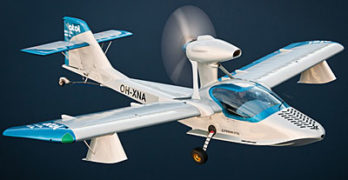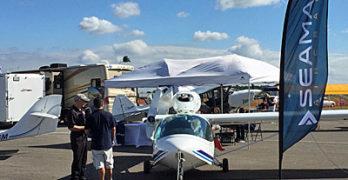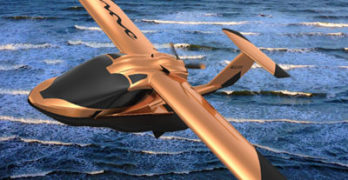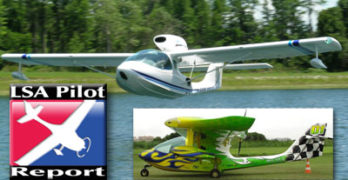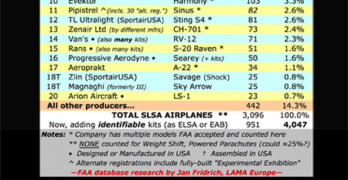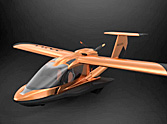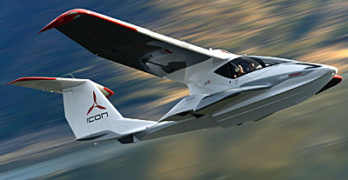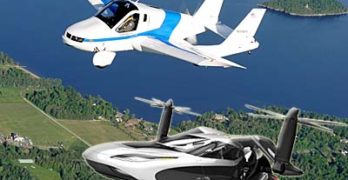In the fascinating LSA seaplane sector-within-a-sector, we find both good news and bad news today, though the latter can be overcome. That’s the shortest possible story. More detail follows.
The Good
“It is with great pleasure we can report that Equator Aircraft Norway achieved first fully balanced flight with the P2 Xcursion prototype aircraft over the newly painted runway 22 at Eggemoen Technology Park in Norway,” reported the company. Here’s our earlier report on this fascinating project.
Tested by Eskil Amdal, Equator reportedly accelerated to 70 knots before leaving the ground and flying down the runway at 100 knots at nine meters (about 30 feet, at the edge of ground effect), before landing smoothly. Amdal reported stable flight with good controllability in all axes. Two more flights were performed the following day, further establishing confidence in the flying characteristics.
“The aircraft is a prototype developed by Equator with very limited means since 2010,” explained the company.
Search Results for : Icon A5
Not finding exactly what you expected? Try our advanced search option.
Select a manufacturer to go straight to all our content about that manufacturer.
Select an aircraft model to go straight to all our content about that model.
SeaMax LSA Seaplane from Brazil Now Delivering in America
Years ago, back in the early days of the Light-Sport Aircraft sector exploding into the world of aviation, of affordable aviation, one of the early entries was SeaMax, from a Brazilian-based company called AirMax.
An old friend in the business and a supremely capable pilot named Carlos Bessa helped SeaMax successfully prove standards compliance to win approval as a Special LSA (#63 of 143 on our SLSA List). Although Chip Erwin’s Mermaid was attracting a lot of attention at the time, SeaMax was an attractive offering.
Another longtime friend in the business, Tom Peghiny — the man behind Flight Design USA but also an astute observer of light aircraft — urged me to go examine the SeaMax. He thought it possessed qualities I would appreciate. He turned out to be spot on.
Subsequently I flew SeaMax for about four hours with Carlos, spread over a few days.
Vickers Oshkosh Forum to Describe Progress toward Wave Light-Sport Aircraft Seaplane
Now that we are in the middle of winter, activity is brisk. Middle of winter!? Down under in New Zealand, residents are presently in the colder months of the year. Pilots in U.S. states currently sweating through summer may need a moment to ponder that.
New Zealand may be a long ways away but the Vickers Aircraft team building Wave are bringing their fascinating aircraft ever closer. As they work, they are gaining experience with new equipment used to build Wave LSA seaplanes.
“Our tooling is all in place now,” said CEO Paul Vickers. “Initial parts are coming out of molds and they are matching the CAD files perfectly.” Modern design, even of more affordable aircraft, are often fully created on computer work stations. The days of hand making a prototype are passed and the older way is nearly extinct.
“We’ve also recently doubled the size of our facilities,” added Paul.
SeaMax Light-Sport Aircraft Seaplane Returns to American Market—Pilot Report
SeaMax from Brazil has been somewhat absent in recent years. I will spare you the detail but the company used a lot of energy to repel an undesired takeover. In recent months that was resolved and the company is now ready to move forward smartly.
SeaMax was an early LSA to meet the consensus standards as required by FAA. The first was the Mermaid in February 2006. Second was the Colyaer Freedom on January 2007. On Christmas Day 2007, SeaMax became the third.
However, of those three only SeaMax has remained in regular production for the last ten years. More recently, SeaMax was followed by SeaRey, Super Petrel, and A5 as ASTM-compliant LSA seaplanes. See our SLSA List for all aircraft shown in sortable columns.
At Sun ‘n Fun 2017, I did a video interview with designer Miguel Rosario that you can watch below.
Light-Sport Aircraft Market Shares for Fleet and 2016
A dozen years after FAA created aviation’s newest sector, we have a new leader among manufacturers of fully built Light-Sport Aircraft. CubCrafters has been moving upward with several years hitting 50 deliveries. In 2016 the west coast builder finally topped perennial leader Flight Design, which slipped to second place. The CT builder had occupied the #1 position since the beginning of Light-Sport Aircraft. Only four aircraft separate the two brands. Note: this article has been updated twice; see at end. —DJ
In the single-year race, Czech Sport Aircraft won convincingly with almost double the next closest producer. The Czech builder performed well in 2015 but significantly increased last year. Congratulations to both companies.
To explain further, our “whole fleet” market share chart — the one we have published going back to 2006 — keeps track of all Special LSA (SLSA) airplanes in the U.S. fleet. Regretfully, we are unable to properly account for weight shift trikes, powered parachutes, gyroplanes, or motorgliders because the database is too variable.
Vickers Aircraft — Wave LSA seaplane
Among all Light-Sport Aircraft, some of the most intriguing new design qualities are emerging from LSA seaplanes. Icon’s A5 has gained a ton of attention but here’s a new entry from Vickers Aircraft of New Zealand. This aircraft is -not- yet flying (as of late 2016) but is such an innovative engineering exercise that we wanted to interview designer Paul Vickers when he was in the USA arranging aspects of Wave’s debut in America. Stay tuned; we’re sure to have more!
Vickers’ Wave Is Gearing Up Quickly for 2017
Pilots not closely following Light-Sport aviation can be excused for thinking only one LSA seaplane is available. Established LSA companies like Progressive Aerodyne and their Searey or Scoda’s Super Petrel or Airmax’s SeaMax or any number of aircraft to which floats have been fitted may be somewhat baffled by the outsized attention Icon Aircraft’s long-delayed A5 receives from aviation and non-aviation media. On the other hand, most leaders of these companies do admit that Icon’s media juggernaut also brings attention to LSA seaplanes in general.
With that in mind, are you ready for one that might out-WOW the A5? You cannot ride a Wave today, but 2017 may be the breakout year for this impressively-configured LSA seaplane entry from the other down-under country of New Zealand.
Indeed, principal, Paul Vickers — the namesake of Vickers Aircraft — wrote at the end of 2016, “Great strides have been made in the past months here at Vickers.
Happy 12th Birthday, Light-Sport Aircraft!
Earlier this month, Light-Sport Aircraft celebrated a birthday. The date was September 1st, when FAA made the then-new Sport Pilot/Light-Sport Aircraft rule “effective” (to employ FAA-speak). So… happy birthday, LSA.
In those dozen years — the newest aircraft segment is not even a teenager yet — quite a bit has changed. If you are a parent, you may not notice your child getting older as you see them daily. However, the distant uncle or grandparent who only gets to visit infrequently may be astounded how much the little guy or gal has grown. I suspect those close to LSA may have a similar perspective deficit, so let me make some contrasts.
The nearby images are from a talk I gave at the recently concluded Mid-West LSA Expo. I went into more detail than this article permits but I’ll bet you get the points.
AIRFRAMES — Today, we accept that we have some marvelous, sleek, high-tech, well-equipped, well-performing models.
Will Third Class Medical Reform Hurt LSA?
One of the most common questions I got at Oshkosh 2016 was the title of this article. I’m only one person with an opinion, but since I work with many airframe producers in the LSA space, I heard this question fairly often, several times from airplane sellers who were curious what other producers thought.
Just shy of five years ago, EAA and AOPA caught the LSA industry off guard by announcing plans to push FAA to drop the Third Class medical. Most LSA professionals likely agree with the basic idea that FAA ought to keep their noses out of the recreational end of aviation. Many feel that the medical requirement has prevented almost no accidents. Nonetheless, this new initiative took aim at the primary reason LSA builders were then selling airplanes like crazy. If you wanted to fly without a medical you had ultralights (Part 103… and still do), or sailplane motorgliders, or Light-Sport Aircraft.
Flying Car Racing Event & Terrafugia New Weight
If my title confuses you, regrets. The two are related in my mind but not in present-day fact. Nonetheless, I found both interesting and hope you do, too.
First, the fact. Terrafugia, of current Transition Roadable Airplane or flying car fame, won a weight exemption up to 1,800 pounds. This blows past the 1,680 pound exemption won by Icon Aircraft for their A5 LSA seaplane (only 1,510 pounds of which they chose to use). Earlier Terrafugia was granted an exemption to the seaplane LSA weight of 1,430 pounds but that didn’t prove to be enough.
A problem, perhaps the major problem, for Terrafugia is contained in the Federal Motor Vehicle Safety Standards (and let’s be just as government as we can be to go with the inescapable abbreviation of FMVSS). You cannot take to the air with any airplane heavier than an ultralight vehicle (254 pounds empty plus certain exceptions) without satisfying lengthy FAA regulations and you cannot put a non-kit car on the road without meeting the considerable requirements of FMVSS.
- « Previous Page
- 1
- …
- 10
- 11
- 12
- 13
- 14
- …
- 16
- Next Page »


